Gigantopithecus Captured!
Posted by: Loren Coleman on February 8th, 2008
On December 1, 2007, before my “Introduction to Cryptozoology” talk, I toured the American Museum of Natural History’s exhibition on Mythic Creatures. In their moderately-sized exhibition hall, I felt one of the highlights was the corner they set aside for unknown hairy hominoids.
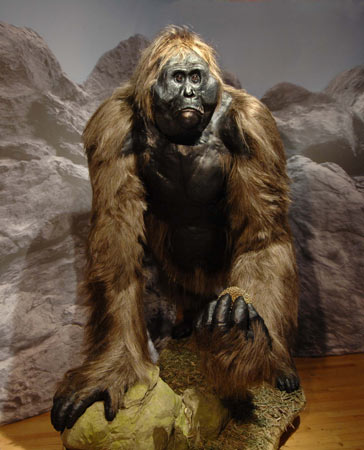
The Gigantopithecus model was a wonder. It appeared as above, large and Yeti-like for all the world to ponder.
The photographs below might give an insight into a different kind of feeling.
Cryptomundo correspondent Trey Howell had just finished reading Bigfoot! The True Story of Apes in America and found himself at the American Museum of Natural History during the middle of this week.
He was wandering around the halls. Trey “passed a TRex, turned a corner and behind some barriers in a crate [he saw] the full scale Gigantopithecus model.” What he saw was startling and remarkable.
He had discovered the museum was breaking down the recently closed exhibition Mythic Creatures, near the Dinosaur wing on the 4th floor. Being a well-prepared Cryptomundian, needless to say, he had his camera at ready. He snapped off some pictures to share with me, and by extension Cryptomundo.
Is this a peek into the future, to how it will look when the first Gigantopithecus or Yeti or Sasquatch is captured?
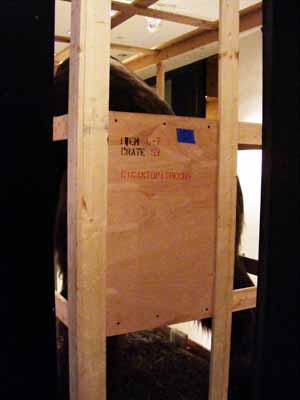
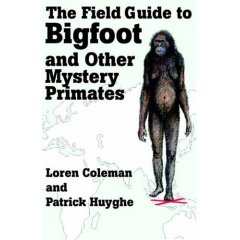
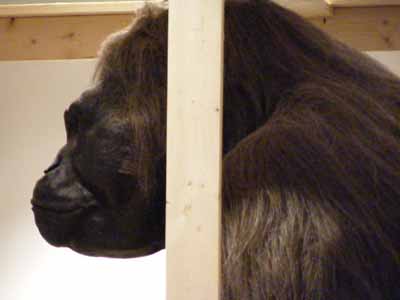
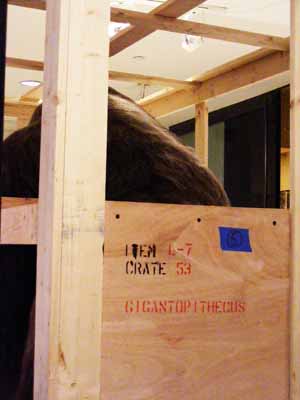
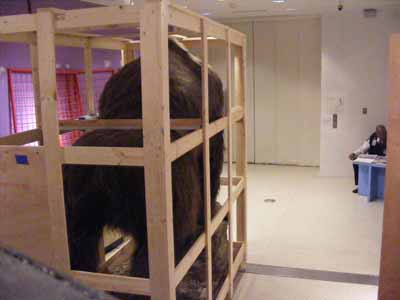
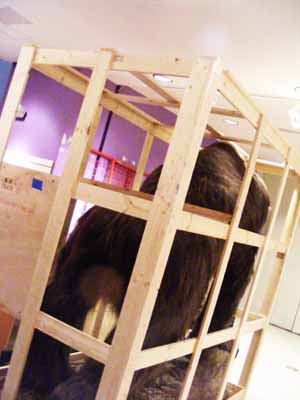
What will the first trapped but living Abominable Snowman look like?

These photos give a sense of the power evidenced in such a meeting between one of these Pleistocene giants and our ancestors. For an individual who has encountered one more recently, the beast’s appearance must go beyond easy descriptions.
Photos by Trey Howell.
About Loren Coleman
Loren Coleman is one of the world’s leading cryptozoologists, some say “the” leading living cryptozoologist. Certainly, he is acknowledged as the current living American researcher and writer who has most popularized cryptozoology in the late 20th and early 21st centuries.
Starting his fieldwork and investigations in 1960, after traveling and trekking extensively in pursuit of cryptozoological mysteries, Coleman began writing to share his experiences in 1969. An honorary member of Ivan T. Sanderson’s Society for the Investigation of the Unexplained in the 1970s, Coleman has been bestowed with similar honorary memberships of the North Idaho College Cryptozoology Club in 1983, and in subsequent years, that of the British Columbia Scientific Cryptozoology Club, CryptoSafari International, and other international organizations. He was also a Life Member and Benefactor of the International Society of Cryptozoology (now-defunct).
Loren Coleman’s daily blog, as a member of the Cryptomundo Team, served as an ongoing avenue of communication for the ever-growing body of cryptozoo news from 2005 through 2013. He returned as an infrequent contributor beginning Halloween week of 2015.
Coleman is the founder in 2003, and current director of the International Cryptozoology Museum in Portland, Maine.










Amazing what one can imagine from a handful of teeth.
I mean, that is a *marvelous* model! But whether or not it looks anything like a real gigantopithieus?
My God !
When I read the title I thought there was a real Gigantopithecus captured !!!
aaaaaaaaaaaaaahhhhhhhhhhhhhhh
Very nice. For a split second there when I saw the headline I thought a live Bigfoot had been finally captured! Lol. Not that I think Gigantopothecus Blacki is Bigfoot of course, he probably isn’t. Perhaps he evolved from him though. 🙂
Any idea if this exhibit will be touring? Seems like a waste to create those wonderful displays and then secret them away in the depths of the AMNH, which are labyrinthine according to author Douglas Preston.
I really no see how Gigantopithecus can be identified as either the yeti or bigfoot as it was certainly not bipedal for the majority of its life.
About the time of the proposed Gigantopithecus move across the Russia-Alaska land bridge, the US had 1 of the largest land predators which ever lived that prevented human colonisation of North America, unless Gigantopithecus crossed in great numbers or were able to physically over the giant Short Faced bear, I don’t see Gigantopithecus as a viable solution to the Bigfoot phenomena.
Also Gigantopithecus is assumed to be the same colour as orangutans, as these creatures have lived in similar forest conditions & their fur not changed, I don’t see why Gigantopithecus would need to evolve into a different colouration.
Whenever, and whatever we capture, I hope we capture it alive.
Great pictures Loren and special thanks to Trey Howell for the opportunistic photos.
I don’t think the 2×4’s will hold him 🙂
I’m gonna need a bigger trap…and a little help getting him into the back of the truck.
Captured?
Gigantopithecus underscores the fact that a similar creature is possible.
I personally think it unlikely Sasquatch is Gigantopithecus.
Great pics.
Looks like something I hope I never ever in my life time see.
Glad to see I wasn’t the only one who got a bit over-excited about the article’s headline.
Very funny Loren. Ha, Ha 😉
Does anyone know who’s the master sculptor behind this wonderful creature?
hey loren wonderful new article about gigantopithecus. thanks bill green 🙂
I agree with bill green
well done loren
I would like to see someone capture one. It would be great. I would not like to be in on the chase, however. Something that big and powerful would require careful and deliberate planning.
I would really hate to be there if things backfired and left Ol Sas in a state of high irritation. On second thought, perhaps I would be just as happy to only see one, and that others would just leave it alone.
Finding the first teeth of Gigantopithecus was somewhat of a fluke, We could have easily never known of this animal. So I think its strange that many people like Dr. Jeff Meldrum for example (whom I greatly respect) believe Sasquatch to be related, if not Giagantopithecus himself, since there may well have been more large apes of the pleistocene that could give rise to Sasquatch.
That is if Sasquatch really does exist.
That’s a great model. Speculative yes, but speculation based on reasonable inferences in evolutionary cladistics and evolutionary ecology.
As for the question of giganto as sasquatch or sasquatch ancestor, I also think it is rather unlikely, but the reason it is proposed is because there are very few other even remotely plausible options (the only other, in my opinion being a relative of homo erectus, but that is about as imporobable as the giganto theory)
Interesting observations:
1) inferring THAT monster from a handful of teeth and a jawbone;
2) the pretty-much-standard presumption that Giganto is an ancestor or related to the sas, both of which I consider kind of unlikely.
Scientists – mainstream and non – make all kinds of mistakes and unfounded assumptions. (Grover Krantz was a virtual fountain of them. One of my favorites: that the sas is unsteadier on its feet than we are, when not only the copious sightings but the film that Krantz himself studied paint a far different picture.) We have this insatiable need to state a conclusion whether we have one or not.
You would think someone would want to find this thing, and know.
I wonder where this model will end up? I hope that it won’t spend the rest of it’s days in some dusty museum storage. FYI…I do have room in my living room(LOL)!!!
A fun post.
Gigantopithecus is considered closer to an orangutan than a gorilla. The frontal photo seems to reflect aspects of the orangutan. Yet, the profile photos seem to be more gorilla like.
Posts above suggest doubts that giganto is related to bigfoot. This is interesting because most of the professional cryptozoologists argue for a relational connection between the ancient ape and the contemporary “great American ape”.
Personally, I think we should harbor doubts
about the reality of bigfoot. But, for the sake of argument, let’s take for granted as true the following two statements:
1. Conventional science is correct and giganto and all proto-humans died out ages ago, leaving no ancestral types (except humans, of course).
2. Bigfoot, as generally conceived, exists.
What then, is bigfoot?
Must we link Bigfoot to giganto or homo erectus (for instance), for it to make sense? Do we rethink what bigfoot might be? Is bigfoot what the natives always said it was: a giant form of human? Is it a hybrid of some sort? (I think the hybrid idea used to be more prevalent, before the pros began to link bigfoot to evolutionary science). If it is a hybrid, a hybrid what?
“Posts above suggest doubts that giganto is related to bigfoot. This is interesting because most of the professional cryptozoologists argue for a relational connection…”
I think that if we had any “professional” cryptos we’d have the sas by now. (If they’d existed in 1968, P/G would have been verified within the year.)
Scientists love to pigeonhole into what is known. No surprise; they’re people, after all. I think that many of the theories about the sas have come from cryptos who just came up with POSSIBILITIES that might stem from the “lack of evidence.”
I used to think that the sas was a very very rare animal that migrated over ranges that would dwarf those of any other known mammal.
Now I see that there’s so very much evidence that neither of those “explanations” is necessary.
We only have a few teeth.
This means that we do not know:
How exactly big it actually was.
Whether it was bipedal or quadrupedal.
What color fur it had.
How much sexual dimorphism it had.
And pretty much anything else.
As a result of guesses based upon house-of-cards of guesses, yes, it is a fantastic (and very lifelike) model.
Sightings of the Yeren may mean that a few are still around. One can hope.
Since we now know that none of the australopithicines, or ardipithicus, kenyapithicus, etc, were any more bipedal than modern bononos, we don’t have a good clear ancester for sasquatch. Erectus, Heidelbergensis and Neandertal were identical to us below the neck (and once you hook the jaw on the hinge instead of setting it way forward, even the skulls fall within modern human known ranges). So, we are lacking understanding. And we’ve long known that we have nothing known like the double-jointed foot that Dr. Meldrum hypothesizes from the footprints.
Orang Pendek is very interesting, and I hope we find it and preserve it before it is too late. More bipedalism than the bonono, but still has the big toe sticking out and arm-waving behavior typical of a brachiator. Is there a connection with the bipdedal Napes of the west and north-west?
It is hard to imagine any one of the genus (or just species?) homo to have lost the use of fire and tools. So what is bigfoot? Some third option we don’t know about yet?
“a handful of teeth and a jawbone”
“We only have a few teeth.”
China has yielded three Gigantopithecus blacki jawbones and over a thousand teeth.
Part of a distal humerus was discovered in Jianping County, Liaoning, China, which has been tentatively assigned to Gigantopithecus blacki.
India has been the source of Gigantopithecus giganteus (= bilaspurensis) teeth and a jawbone.
Vietnam’s new findings show that Gigantopithecus teeth are being discovered there too.
Loren:
Still only teeth; a jawbone (or three); and part of another bone.
A little of an animal – and a lot of a guess.
But then, we KNOW virtually nothing about the dinosaurs either.
Im speechless those are good photos of the model ape, now only if science can get a body of a yeti or bigfoot, so studies can be done. If bigfoot or the yeti are a combination of man and ape that is truly one huge creature truly remarkable.
Hi all
Everyone seems to think that humanoid life entered the Americas through the frozen north. There was however human life in this continent long before the indians which came from the south, and is still found in some argentine islands, thats right the aboriginals.
If they travelled from Australia or more northerly to get there then is it impossible that large primates could have also used this path to enter the america’s.
Maybe people are looking in the wrong place.
Anyway, back to the model. Superb, and it is surprising what they can conclude from small amounts of evidence, I’m not so sure that this is or has anything to do with sas though, just a hunch.
It is a beautiful model of what could have been in existence back then, but not quite what people report when they encounter a Bigfoot/Gigantopithecus of today. One of the biggest details given as we all know aside from its massive height and weight is its ability to walk upright just like us. This model to me looks more like an oversized gorilla, and as sad as this sounds gorillas are tracked and killed all the time, while on the other hand Bigfoot is obviously very elusive and probably very intelligent as well. I don’t think this model has anything to do with the the Bigfoot people are encountering today.
I look upon the phylogenetic assumptions of many modern academics as so much wishful thinking. Looking backwards in time requires as much astute and logical imagination as paleological discovery. Is sasquatch a example of a remnant population of Gigantopithecus? Who the hell knows, I don’t, neither do any of you, (academics included). To decree that the Gigantopithecus of millennium ago was a strict vegetation for instance is foolish. Because the creature ate salad (bamboo) does not mean he didn’t enjoy it with an occasional steak. The very structural nature of the course bamboo would leave the observed silica filled (opal phytoliths) dentition, but certainly, that does little to indicate the entirety of the creatures diet. To suggest that ‘Giganto’ subsisted entirely on bamboo is a perfect example of agenda driven scientific reasoning. Perhaps meat leaves behind some observable residue on millennia old teeth I’m not aware of. I doubt it.
The Gigantopithecus question as it relates to sasquatch is fraught with speculation and agenda driven opinion, pseudo-science and one half-baked assertion.
One poster parrots the speculation that Gigantopithicus could not have migrated across and southward through Beringia because of the abundance of predators there. Well then how did man come to migrate southerly through Beringia. By extension of that logic man even with his advanced intelligence, would not have been able to survive the deadly haunts of short faced bears, large lions, saber tooth tigers etc. either. This is to totally fail in understanding even the present day relationship between apex predators and man.
A very large manlike (relatively cunning and intelligent), bipedal creature would have a significant advantage in successfully navigating the land and evading or eliminating particular predators. In fact the existence of large predators would encourage a species adaptation through growing to a very large size. Such adaptational growth in large mammals in response to predation threats is not without precedent. And in fact there are several ecological stressors that were and are extant within the Northwestern biotope.
If we look at the question from the other direction and ask ourselves; would the sasquatch of today as we have come to think of it—intelligent, formidable if need be, cautious, observant, hyper vigilant, fast, able to quickly climb limbless trees; (hint-hint) possessing incredible strength and if that weren’t enough; thoroughly nocturnal; be able to exist in a relatively kind climate (Ancient Beringia) populated by abundant apex predators and even early man—the answer would have to be an unequivocal YES.
While we may never know the exact relationship between what was probably a bipedal ape of enormous proportions and sasquatch, we have to make a connection between what has been contemporarily observed in the description of sasquatch and what has been speculatively proposed in the construction of Gigantopithicus blackii models. To conclude that Gigantopithicus died out as a result of competing hominids or predators is at this point totally baseless.